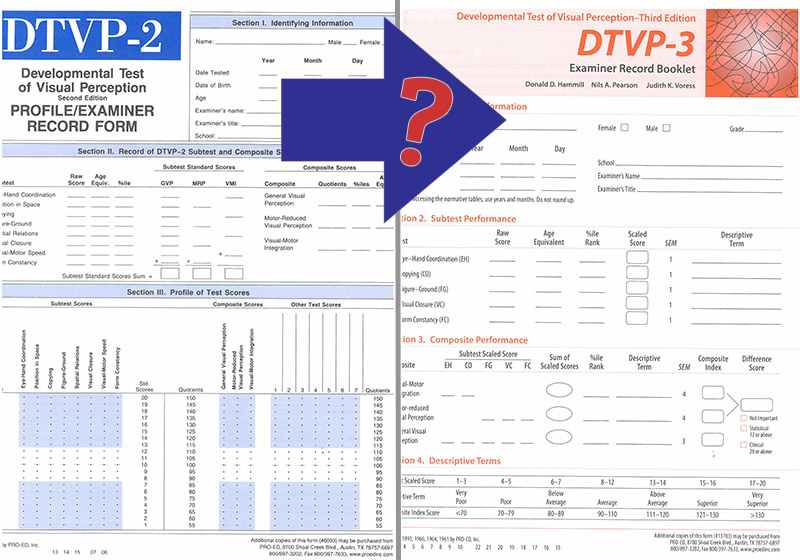DTVP-2 vs DTVP-3: A Worthwhile Upgrade?
The Developmental Test of Visual Perception (DTVP) has been around a long time. It was developed by Marianne Frostig and colleagues in the early 1960s, and first standardised in 1963. The DTVP-2 was released in 1993, and most recently, the Third Edition of the DTVP was published by Pro-Ed in 2014 with updated norms. But has much really changed?

You can find the "official" list of changes on the publisher's website, so I'm not going to repeat that, but instead share my experience. My workplace has purchased the DTVP-3 at the start of 2015. At first glance, it appeared to me that the packaging had just been made more colourful, and a few of the subtests removed. However, having now used it, I am thankful for the small changes that have made the assessment much easier to administer.
Things to like:
- The Visual-Motor Speed and Spatial Relations subtests are gone! I used to get frustrated marking these, as the marking criteria was very strict about where the pencil marks were allowed to be. I felt the children were losing marks unfairly, as the aim of the Speed subtest is to mark as many correct shapes as possible, but an otherwise correct answer wouldn't count if the mark protruded outside the shape.

Removed Subtests: Visual-Motor Speed and Spatial Relations
-
Not only has removal of three subtests (Position in Space, Spatial Relations, and Visual-Motor Speed) meant shorter administration time, the change in order has helped test administration run more smoothly. No longer do we need to switch between the response booklet and the stimulus booklet for each subtest.
-
The layout of the Examiner record form has become much more user-friendly. It now includes the standard wording for explaining the tasks, and the responses are much easier to instantly mark correct or incorrect by the bolding of correct responses.

Completely new layout of the Examiner Record Booklet
- The layout of the Response Booklet has been improved. There is now more space between items. Some of the pictures in the Eye-Hand Coordination Subtest have changed, fairly inconsequentially. The Copying Subtest has been reordered to better reflect the developmental progression of drawing skills. Scoring this subtest has also been much improved with provision of a Scoring Template, which includes all the necessary angles and measuring lines for accurate scoring.

Improvements to the Copying Subtest
- Even the Stimulus Booklet has had a facelift. It now includes the letters corresponding to the answers, under each figure. I've found it useful to double-check sometimes if the child points too quickly by saying "was that 'B' and 'F'?" There are some new items, and all the items now have the potential answers laid out in a single row.

Updated layout of Stimulus Booklet
- The Visual Closure subtest has been re-graded to include more simpler items at the early stages, with more difficult items moved toward the back. As shown in the example below, the layout has been improved. This item has been moved from fourth place to sixth, with easier items inserted beforehand, to more closely follow the developmental progression (i.e. more horizontal and vertical lines before diagonals). The subtest has been expanded from 20 items to 26.

Comparison of Visual Closure Subtest Items
- Norms are now provided up to 12 years 11 months. I find this very convenient, because the same assessment can be used in early primary school, and again for comparison around the age of transition to high school.
Things to question:
-
Although this assessment has been around a long time, we are yet to have international standardisation. The DTVP-3 boasts impressive reliability and "is shown to be unbiased relative to race, gender, and handedness." Is it valid for use with Australian children?
-
Was the removal of the Spatial Relations subtest beneficial? Was that data useful?
-
Now there is no component taking into account the speed of visual-motor integration tasks. Is speed of completion relevant in assessing proficiency? I would have thought so.
Please share your thoughts. Comment below…
*Post updated 8th Jan 2016